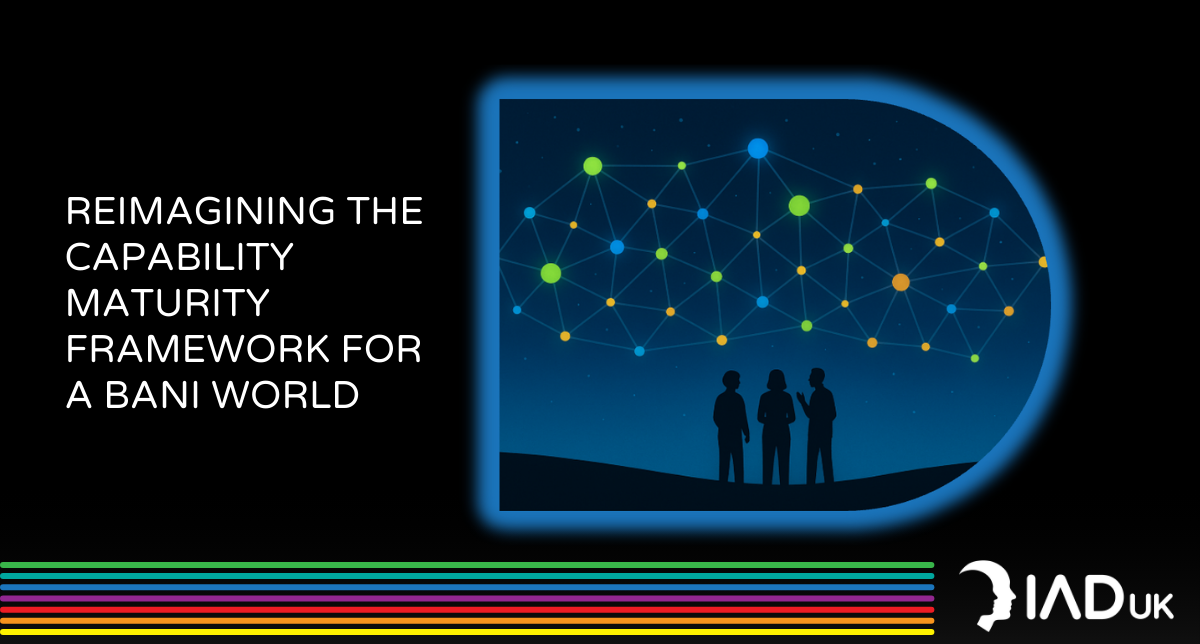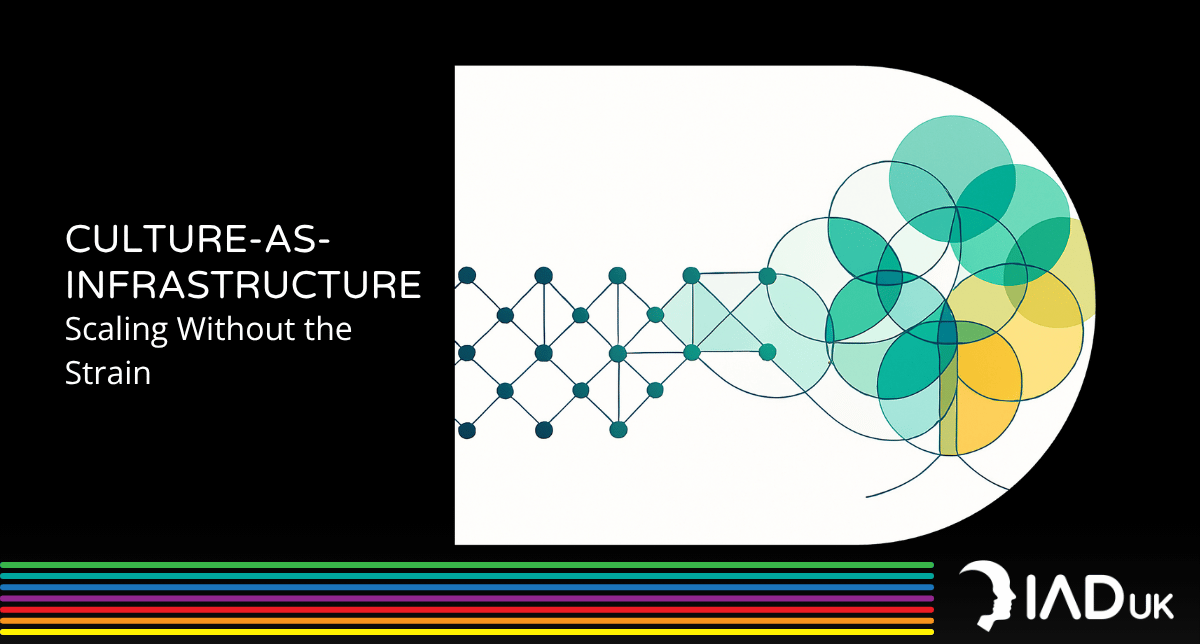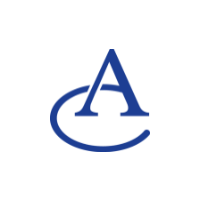Why Hybrid Work Is Exposing a Leadership Crisis - and How to Fix It
What if the real hybrid challenge isn’t where people work, but how leaders think?

The debate over hybrid work is polarising, and increasingly personal. On one end, we have leaders like former M&S Chairman Stuart Rose declaring that remote workers are “not doing proper work”¹. On the other, Mark Mullen, CEO of Atom Bank, calls enforced office returns old-fashioned “command-and-control thinking”². Both men are reacting to the same phenomenon, yet interpreting it through entirely different leadership lenses.
What’s beyond debate is this: hybrid work is no longer an anomaly. It’s the norm. As of late 2024, more than 28% of working adults in the UK are now in hybrid arrangements³. Employees value the autonomy, flexibility, and focus that hybrid setups offer. But many leaders? They’re struggling. And not just logistically but cognitively.
We often assume the tension around hybrid work is about where people work. But the truth runs deeper. The real issue is not the policy, it’s the leadership models that underpin it. The ones many organisations still rely on were built for a different era. An era of proximity, hierarchy, and predictability. Hybrid work has shattered those assumptions, revealing a leadership gap that’s no longer possible to ignore.
Leadership today is no longer about managing performance through presence, it’s about cultivating clarity, trust, and resilience across multiple contexts. But few leadership development approaches have evolved to reflect this. As a result, hybrid work hasn’t just changed how people work. It’s exposed a fundamental mismatch between the complexity of our working environments and the capabilities of those tasked with leading them.
This isn’t an indictment. It’s a wake-up call. Because if leadership doesn’t evolve to meet this moment, the fallout won’t just be frustration or inefficiency, it will be disengagement, disconnection, and eventual decline.
So the question becomes:
what kind of leadership is required to thrive in a hybrid world, and how do we develop it before the cracks become irreparable?
The Symptoms: What We’re Seeing on the Ground
Hybrid work hasn’t just changed the mechanics of work—it’s reshaped the terrain of leadership. And the symptoms of this shift are showing up everywhere.
The Employee View: Autonomy or Ultimatum?
Employees are drawing a firm line: flexibility is no longer negotiable. A 2024 survey found that 48% of UK professionals would consider quitting if forced back to the office full-time4. For many, the hybrid model offers more than convenience. It provides alignment: with how they think, live, and perform at their best.
Employees don’t want less accountability, they want more meaning. They want to be trusted. And when that trust is reciprocated through thoughtful leadership, hybrid teams can outperform even the most polished in-office setups.
But when that leadership fails to materialise, the experience can feel isolating, unclear, or worse, arbitrary.
The Leadership Lens: Complexity Without a Compass
Hybrid work isn’t simply a new location strategy. It’s a fundamentally different leadership challenge, one that many leaders are unprepared for.
Unlike traditional office or fully remote setups, hybrid requires leaders to span multiple realities simultaneously: managing presence and absence, clarity and ambiguity, autonomy and alignment. As McKinsey notes, these “unprecedented challenges” mean that hybrid leadership is not just a shift in style, but in substance5.
Leaders must now:
- Maintain culture without relying on physical presence
- Build trust without casual encounters
- Provide clarity without proximity
- Inspire action amid digital fatigue
And they must do this while facing rising pressure, shrinking margins, and a workforce that rightly expects more than just direction; they expect developmental support.
This complexity adds weight to a role already under strain. According to the 2023 Global Leadership Forecast, burnout among leaders has reached a new high: 60% report feeling “used up” at the end of each workday6. And while hybrid work isn’t solely to blame, it compounds the cognitive and emotional demands leaders already face.
Trust, Engagement, and the Quiet Erosion of Vision
Perhaps most concerning is what hybrid subtly erodes when not actively led: vision.
In dispersed teams, it’s harder for a compelling vision to travel. Informal channels—lunches, hallway conversations, body language—once helped reinforce meaning and belonging. Now, that connective tissue is thinner. The onus is on leaders to intentionally construct environments where alignment, clarity, and energy can thrive.
Many aren't equipped for this. Not because they lack will—but because they haven’t yet developed the cognitive range required to lead with nuance, flexibility, and responsiveness across changing contexts.
And that is precisely what’s needed now.
The Deeper Diagnosis: Hybrid Exposes a Lack of Thinking Complexity
It’s tempting to view the challenges of hybrid work as issues of logistics, communication, or culture. But peel back the symptoms, and something deeper is revealed: most leadership breakdowns in hybrid environments stem not from poor tools or disengaged teams—but from
insufficient thinking complexity.
Linear Thinking in a Nonlinear World
Traditional leadership relies on linear thinking: clear inputs lead to predictable outputs. This works well in stable environments, where routines are fixed and context rarely shifts. But hybrid work isn’t stable. It’s a constantly shifting, high-ambiguity terrain where the rules keep evolving, and where what works for one person, one day, in one context, might fail completely in another.
Yet many leaders continue applying outdated models: set the vision, cascade the comms, hold people accountable through KPIs. In hybrid? That often leads to frustration, confusion, and disengagement. Why? Because hybrid introduces complexity that can’t be solved by simply scaling what worked before.
Hybrid is nonlinear. Feedback loops are slower. Human signals are harder to read. Culture can no longer be policed through proximity. And leaders who expect straightforward solutions quickly find themselves overwhelmed, not simply by hybrid itself, but by the layered complexity it introduces.
Enter Dynamic Intelligence: The Missing Meta-Skill
This is where Dynamic Intelligence (DI) becomes essential. Unlike traditional leadership skills that focus on what to do, Dynamic Intelligence focuses on how leaders think about what to do. It’s not just about being more informed, it’s about being more aware, more adaptive, and more capable of intentional choice in the moment.
Defined by the Institute for Adult Development, Dynamic Intelligence is “our capacity for consciously choosing our thoughts and actions in response to varying circumstances and contexts”⁷. It rests on four core elements:
- Intention — the often-unconscious mental patterns that guide initial responses
- Awareness — the ability to recognise those patterns and understand their impact
- Choice — the capability to select more effective patterns of thought
- Response — acting with intentionality, not reactivity, in real time
Together, these enable a leader to construct and reconstruct their thinking on the fly, based on context. This isn’t just self-awareness—it’s
cognitive agility. And in hybrid environments, it’s the difference between leading by default, and leading by design.
Hybrid Isn’t the Problem—It’s the Exposure
Hybrid work, then, isn’t the root cause of the leadership challenges we’re seeing. It’s the amplifier, the X-ray that reveals where a leader’s thinking lacks complexity, where their models are brittle, and where they struggle to adapt when the script changes.
What hybrid exposes is not just a need for more training, it’s a need for development. Not horizontal development (more knowledge, more tools), but vertical development: growth in cognitive capability. The ability to think in more nuanced, flexible, and systems-aware ways.
In this light, hybrid work isn’t a hurdle to be overcome, it’s a catalyst. A signal that the complexity of work has evolved, and our leadership must evolve with it.
The Developmental Arc: Where This Goes
Leadership, like development, is always moving. The only real question is: in which direction?
Hybrid work has disrupted the status quo, but it hasn’t replaced it with a new one. Instead, it has opened a fork in the road. One path leads to deeper disconnection. The other, to more adaptive, human-centred, and future-fit leadership. The choice is ours. But the cost of indecision is already showing.
The Downward Path: Ignore It, and You Erode Performance
Let’s be clear—doing nothing is a decision. When organisations refuse to adapt their leadership to the hybrid context, they don’t preserve stability. They accelerate dysfunction.
The results? All too familiar:
- Disengagement deepens. Employees feel unseen, micromanaged, or misunderstood.
- Turnover climbs, especially among high performers seeking more developmental cultures.
- Performance erodes—not due to lack of effort, but due to misalignment and motivational drift.
- Culture begins to decay as proximity-based influence gives way to silence, cynicism, or quiet quitting.
And at the leadership level, the cost is even steeper: burnout, decision fatigue, and a creeping sense of irrelevance, exacerbated by the heightened complexity of hybrid dynamics. Leaders who once felt confident navigating clear hierarchies now feel unmoored, unsure how to manage in a space where relationships, not rules, are the currency of influence.
This isn’t a failure of intention, it’s a failure of evolution. And in today’s environment, not evolving is indistinguishable from falling behind.
The Upward Path: Engage It, and You Catalyse Transformation
But when organisations choose to face the challenge, when they invest in developing their leaders’ capacity to think with greater flexibility, nuance, and awareness, something extraordinary begins to happen.
- Trust grows. Leaders become more emotionally intelligent, less reactive, more attuned.
- Innovation rises. Complexity stops being overwhelming and starts becoming a source of possibility.
- Resilience increases. Leaders bounce back faster because they no longer need control to feel confident.
- Collaboration deepens. Hybrid work no longer fragments the culture, it amplifies it through deliberate design.
And over time, a deeper transformation unfolds. Leadership is no longer about enforcing consistency, it’s about creating the conditions for adaptability. The organisation begins to shift from a culture of command-and-control to one of continuous co-creation.
This is the early stage of what the Institute for Adult Development calls a Consciously Constructing Culture™, a workplace where personal development isn’t a bolt-on but the bedrock of performance, trust, and evolution⁸.
From Hybrid Headaches to Developmental Leverage
Viewed through this lens, hybrid work becomes a proving ground. Not for policy compliance or productivity metrics, but for how well your organisation has prepared its leaders to meet complexity with capability.
Because the hybrid challenge is not going away. If anything, it’s a preview of what’s to come: increasingly distributed teams, rapidly shifting demands, and a deepening expectation that leadership is developmental, not just directive.
The organisations that thrive won’t be those that fixate on where people work. They’ll be the ones who understand that how people think is the real leverage point, and who choose to grow their leadership accordingly.
The Missing Piece: Why Thinking Complexity Is the Real Leverage Point
When leaders face challenges in hybrid work, disengaged teams, strained communication, declining trust, the instinct is often to reach for technical solutions. Better tools. New platforms. More structured workflows.
And while these can help, they rarely transform.
Why? Because they solve for
coordination, not
cognition. They improve throughput, not thinking. And when the environment is complex, as hybrid work inherently is, it’s not the tools that fail. It’s the way we think about using them.
The Myth of the Tool Fix
Zoom, Slack, Teams, Miro, Notion, AI-enhanced dashboards: these are extraordinary technologies. But they don’t build trust. They don’t develop intuition. They don’t help a leader know when to hold space, when to intervene, how to navigate unspoken conflict, or how to balance autonomy with accountability.
That’s not a tech problem. It’s a thinking problem.
Or more precisely, it’s a mismatch between the complexity of the environment and the complexity of the leader’s thinking.
This is what developmental psychologist Robert Kegan describes as the difference between technical problems and adaptive challenges. Technical problems have known solutions. Adaptive challenges require growth, especially in how we perceive, decide, and lead.
Hybrid work is an adaptive challenge. And it demands an upgrade, not in your software, but in your cognitive software.
From Set-Mind to Self-Authoring
Most leadership development programs still operate within what Constructed Development Theory would call a Set-Mind, a reliance on fixed responses, inherited templates, and predetermined behaviours. Leaders learn what to do in various scenarios, but not how to rewire their responses when the context defies precedent.
This is the real opportunity of Dynamic Intelligence: to move beyond repeatable patterns and into self-authoring leadership. That is, leadership that is:
- Aware of its own biases, assumptions, and patterns
- Capable of adapting responses in real time, based on context
- Resilient under pressure, not by defaulting to control, but by flexing with purpose
- Visionary not because it clings to the past, but because it is future-literate
When a leader cultivates this level of thinking complexity, they no longer need rigid hierarchies to enforce outcomes. They can lead distributed teams with trust. Make sense of ambiguity without collapsing into fear. Navigate tensions without rushing to resolution.
And most critically they can model the kind of adaptability, clarity, and humanity that hybrid work needs to thrive.
Thinking Complexity as Organisational Infrastructure
Here’s the truth no one talks about: your organisation already has a technology stack. What you need now is a thinking stack.
- Not just performance metrics, but developmental metrics
- Not just engagement surveys, but cognitive assessments
- Not just leadership competencies, but Dynamic Intelligence capacities
This is why the Institute for Adult Development created the Dynamic Intelligence Development System™ (DIDS™), a framework not just for training, but for systematically upgrading how leaders think⁹.
When thinking complexity becomes part of your leadership infrastructure, hybrid challenges no longer feel overwhelming, they feel like the natural terrain for a more capable, conscious leadership culture.
The final piece, then, is action. Because none of this happens through intention alone.
Two Ways to Start
Complex environments demand more than clarity, they demand capability. Not just in operations, but in thinking. If hybrid work has exposed anything, it’s that traditional leadership is reaching the edge of its usefulness. But that doesn’t have to be a crisis. It can be a catalyst.
The leaders and organisations that will thrive next aren’t the ones who double down on control, they’re the ones who upgrade their complexity. Who develop the capacity to think dynamically, respond intentionally, and lead with both precision and perspective.
If you’ve read this far, chances are you’re already one of those leaders, or you’re responsible for developing them.
So, where do you start?
1. Develop Your Organisation’s Thinking Infrastructure
The Institute for Adult Development partners with scale-ups and mission-driven organisations to embed Dynamic Intelligence at every level—from senior leaders to rising talent.
Whether you’re facing burnout, turnover, fractured culture, or leadership drift, we’ll help you:
Map current leadership thinking styles
Identify development pathways based on Cognitive Intention imbalances
Build leadership capacity aligned with complexity—not just competency
Move toward a Consciously Constructing Culture™—where personal development is performance infrastructure
👉 To explore how the Dynamic Intelligence Development System™ can strengthen your leadership pipeline and future-proof your culture, contact us at the Institute for Adult Development.
2. Deepen Your Understanding of Dynamic Intelligence
If you’re curious about the foundations behind this developmental approach, and how it works in practice, we invite you to go deeper.
📘 Download your complementary copy of our book: An Introduction to the Dynamic Intelligence Development System™
Inside, you’ll discover:
- What Dynamic Intelligence really is, and why it matters now more than ever
- How Cognitive Intentions shape behaviour, bias, and leadership
- Why vertical development is the true ROI multiplier for your L&D investments
- How to begin applying these insights in your current role or organisation
Final Thought
Hybrid work is not a temporary blip, it’s the beginning of a much broader shift in how we work, learn, and lead. The question is not whether to adapt, but how soon. Because this moment doesn’t just demand better tools. It demands better leaders. Not just in role, but in thought.
If your leadership culture isn’t developing at the same rate as your operating environment, you’re not leading, you’re lagging.
It’s time to lead differently.
It’s time to think dynamically.
It’s time to develop from the inside out.
Schedule a call to explore how the Dynamic Intelligence Development System™ can strengthen your leadership pipeline and future-proof your culture.
Alternatively, why not download your complementary copy of our new book:
An Introduction to the Dynamic Intelligence Development System™
References:
1. Rose, S. as quoted in The Mail: https://www.dailymail.co.uk/news/article-14304209/Working-home-former-Asda-boss-Lord-Rose-Panorama.html
2. Mullen, M. via The Times: https://www.thetimes.com/business-money/companies/article/forcing-staff-into-the-office-is-old-fashioned-dogma-says-bank-boss-fh80wzt2q
3. UK Office for National Statistics: https://www.ons.gov.uk/peoplepopulationandcommunity/wellbeing/datasets/publicopinionsandsocialtrendsgreatbritainworkingarrangements
4. Hays UK Survey via econostrum: https://en.econostrum.info/uk/uk-employees-ready-to-quit-survey-reveals/
5. McKinsey & Company: https://www.mckinsey.com/capabilities/people-and-organizational-performance/our-insights/its-time-for-leaders-to-get-real-about-hybrid
6. Global Leadership Forecast 2023, DDI: https://media.ddiworld.com/research/glf2023.pdf
7, 8, 9 Introduction to the Dynamic Intelligence Development System™, IAD UK (2024):
https://adultdevelopment.uk/resources/dids-book




